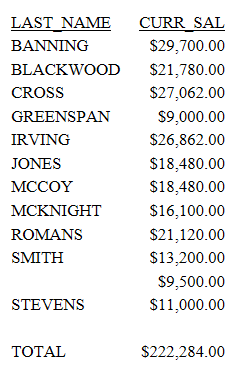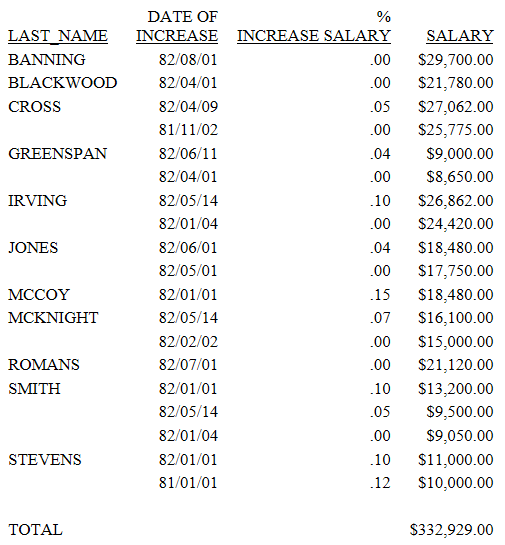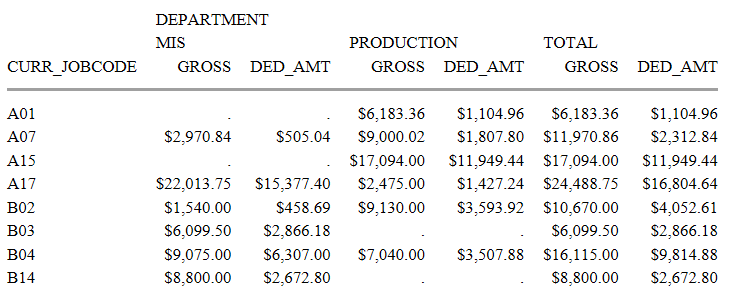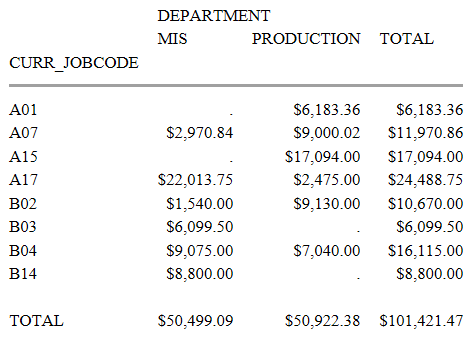Creating Column and Row Totals
|
Topics: |
The exercises in this topic demonstrate how to add column totals and row totals to your reports, using the following commands:
- COLUMN-TOTAL
- ROW-TOTAL
You can add these commands either to the verb phrase in a report request or to the ON TABLE phrase, as shown in the some of the following examples. You also can use the optional keyword AND to connect more than one command in a single request. The AND is included in some examples for clarity and omitted in others for brevity.
Creating a Column Total
Perhaps the simplest kind of total is one that adds the numeric values in a column. You can create totals for all columns that contain numeric data or only for particular columns.
To total the current salaries of all employees, issue the following request:
TABLE FILE EMPLOYEE PRINT CURR_SAL AND COLUMN-TOTAL BY LAST_NAME END
Run the request. The output is:

This report contains one column of numeric data. However, if it had contained another numeric field, for example, gross pay for each employee, that column would be totaled also. By default, COLUMN-TOTAL calculates values for all columns of numeric data.
Suppose that your next report has more than one column of numeric data, but that only one contains data that you want to summarize. To provide you with maximum control over the data you present, you can restrict totaling to that one column simply by naming the field you wish to total in the ON TABLE phrase.
Issue the following request:
TABLE FILE EMPLOYEE PRINT DAT_INC AS 'DATE OF,INCREASE' PCT_INC AS '%,INCREASE SALARY' SALARY BY LAST_NAME ON TABLE COLUMN-TOTAL SALARY END
Notice that this request identifies two columns of numeric data, PCT_INC and SALARY, yet it only asks to total employee salaries, since adding their percentages of increase would not provide meaningful information.
Run the request. The output is:

As requested, the report displays a single column total at the bottom of the SALARY column.
Creating a Row Total
Similarly, you can create row totals by including the command ROW-TOTAL in your report request.
To create a report with totals at the end of each row, issue the following request:
TABLE FILE EMPLOYEE SUM GROSS DED_AMT ACROSS DEPARTMENT BY CURR_JOBCODE ON TABLE ROW-TOTAL END
Run the request. The output is:

Notice that if you use more than one (1) verb object, the output displays a row total for each of the fields, in this case, GROSS and DED_AMT.
Creating Column and Row Totals
You can add column totals and row totals to a report by including both commands in your request. To subtotal gross salary for each department, as well as for each job code, issue the previous request as follows:
TABLE FILE EMPLOYEE SUM GROSS ACROSS DEPARTMENT BY CURR_JOBCODE ON TABLE ROW-TOTAL AND COLUMN-TOTAL END
Run the request. The output is:

Once again, you could produce the same results by including the totaling commands in the verb phrase and omitting the ON TABLE phrase, as follows:
SUM GROSS AND ROW-TOTAL AND COLUMN-TOTAL
| WebFOCUS | |
|
Feedback |